Spice Trade Chronicles 2, Spain and Portugal
Moving along on our Spice Trade Chronicles, and our quest for flavor, Spain and Portugal are next on the route from the United Kingdom.
Spanish explorers changed the land spice trade in many ways. One, being that Spain is bordered on 3, almost 4, sides by ocean, and more produce was able to be grown because Spain’s climate, warmer than England’s, allowed for a greater variety of produce to be grown.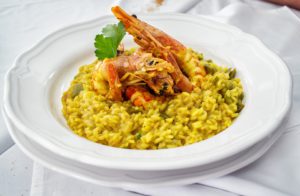
As ancient history is written, two routes were developed for trading spices and other goods. One route went over the land from Japan to the United Kingdom, the other was the maritime, or water route that spanned the same realm, just over water. The water route was way longer, though, in that it allowed explorers to span the globe and discover people and spices that changed civilization forever.
Venetians held the power of the land spice route from the 8th -15th century. They were in the middle between Asia and Western Europe, and charged high taxes on all goods passing through. People were getting rich quickly. But not everyone could afford these high prices. Because spices and herbs were the main ingredient in medicine, they were in high demand and this also drove the prices up. The spice trade involved spices, herbs, drugs, cloth, incense and opium along with lots of money.
When the Ottomans took Constantinople, about 50 years before Columbus discovered America, the Spanish did not want to pay the prices to the non-Christian entity. So new routes by sea were discovered. Routes around Africa had been chartered by Henry the Navigator at the beginning of the 15th century. Eventually, a route around Africa via the Cape of Good Hope, was discovered by the Portuguese navigator, Vasco da Gama. this route allowed spices to be traded along the ports of Spain and Portugal at a much better price. 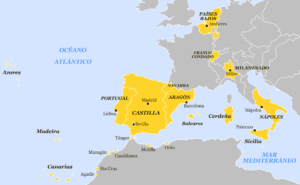
Finding the America’s was more by accident than anything.
Many explorers were trying to copy the route to India around the Cape of Good Hope, and due to high winds and bad weather, they were driven West instead of East, and landed in the Americas, actually the Bahamas. This was not a bad thing as many more salable goods were found. Mainly sugar cane where rum and molasses became highly cherished.
The overland routes that led to the Mediterranean coasts became the maritime routes as people didn’t need to get their spices from the expensive taxed merchants anymore. Europeans once again could get their precious spices and herbs! The Portuguese were the first European seaborne empire to grow from the spice trade. This started the age of European Discovery. Besides just finding new lands and spices, of course, this global expansion also led to significant global changes. These changes affected ecology, agriculture and cultures. New civilizations came into contact with the Europeans which was both good and bad. Friendships were forged by some, but slavery, disease and military conquests for dominance rose in the European colonies leading to war. Christianity spread throughout the new land also, becoming the world’s largest religion!
Fun Fact: When Columbus first landed in the Caribbean on his journey to find India, His navigational equipment wasn’t the greatest and weather had a lot to do with it. He had no idea he wasn’t in India! The crew believed that they were in India, thus naming the indigenous people they met on that island, “Indians.” Allspice, native to the island of Jamaica was taken back to Spain. Rumor has it that allspice was named just that because its aroma reminds you of all the warm spices: cinnamon, cloves, nutmeg and anise.
It was Vasco de Gama, from Portugal, who made it to India in 1497, by way of the southern tip of Africa. He returned from the southwest coast of India with with nutmeg, cloves, cinnamon, ginger and peppercorns. This was the voyage that changed how people cooked!
Shortly after North America was discovered, another navigator, Pedro Álvares Cabral, founded Brazil trying to follow Vasco da Gama’s Atlantic route to the Cape and India. These guys really got around! The Portuguese adopted many of the spices and cooking techniques of South America. Ferdinand Magellan, set out to reach Asia from Spain in 1520 across the Atlantic, and then Pacific Oceans. This voyage brought him around the tip of South American, thus resulting in the founding of the Strait of Magellan! Once Magellan mastered this route, a western spice trade route to Asia was established. Now the world had routes all around the globe.
How did Spanish spices and food develop?
Spain was sort of the play pen of food history. Every culture seems to have passed through Spain at one time or another. Of course, this influenced the food of the region. Cooking was influenced by the people from Greece, Italy, North Africa, Syria, India, and Brazil to name a few.
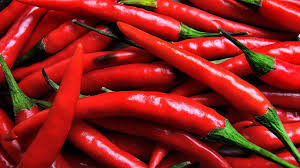
On Columbus’ 2nd voyage, he brought allspice and hot red peppers from the Caribbean which elevated and formed the basis for Spanish cuisine.
Where saffron came from is still a mystery. Some say it came from Greece, and others say Iran. Either way, saffron is probably the most talked about spice in Spanish cuisine as well as the most expensive spice too!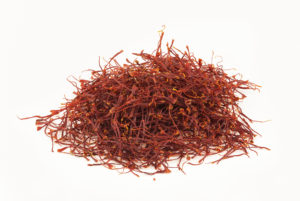
When the route to India became established and navigators finally knew their way around, the spice trade grew rapidly. The port of Lisbon, Portugal imported huge quantities of Indian spices such as cinnamon, cassia, ginger, pepper, nutmeg, mace, and cloves. The king sent out traders throughout Europe, especially Germany to spread the trade route. Portuguese royalty monopolized the pepper trade, this set the bar for business in Europe.
From Greece came olive oil, but the North Africans, or Moors had the greatest impact on making Spanish food what it is today. They introduced fruits, and seasonings, showing different combinations of mixing meat and fish with nuts and fruit. Rice also came from this region, and is used widely in all cooking throughout Spain and Portugal. Saffron, cinnamon and nutmeg were popular spices used in most dishes. Gazpacho comes from the Moors. Spanish food would not be so “spanish” if it were not for the intervention of these cultures during the spice trade. This was the cross-over to the rest of Europe.
When the Americas were discovered this is when tomatoes, vanilla, chocolate, allspice, vanilla, red peppers, various beans, and potatoes became popular in many Spanish dishes.
The most famous Spanish dish known throughout the world is probably Paella. 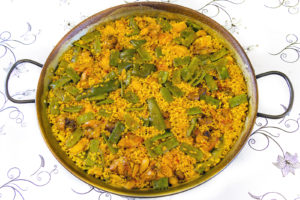 Paella can be made many ways and usually includes seafood, sausage, meats, and vegetables. There are probably as many recipes for Paella as there are cooks who make it. This is every family’s famous dish and everyone makes it their own way. So you can make it and Spice it YOUR Way too! I’ve included a basic paella dish with options included and recommendations for substitutions as well as different methods of cooking it also.
Paella can be made many ways and usually includes seafood, sausage, meats, and vegetables. There are probably as many recipes for Paella as there are cooks who make it. This is every family’s famous dish and everyone makes it their own way. So you can make it and Spice it YOUR Way too! I’ve included a basic paella dish with options included and recommendations for substitutions as well as different methods of cooking it also.
The date when Patatas bravas, or “brave potatoes” was invented is not clear, but it was probably after 1542, when Spain conquered the Incas. This was the time of the great Famine in Europe and people were forced to eat potatoes! Originally, they were considered poisonous and fed to livestock. Once they became “worthy” of consumption, the Patatas bravas were served everywhere. It is a popular treat on tapas menus.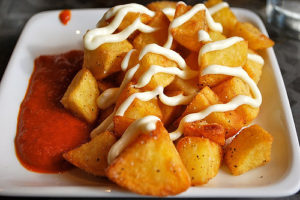
Just like Paella, there are many ways to make it, but one thing remains constant and that is fried potato and a sauce. Either a vinegary tomato based sauce with lots of spices, or a red pepper based sauce with paprika, vinegar and spices. Both types of sauces pack a spicy punch! Aioli, garlicky mayonnaise, is sometimes served alongside, probably to calm the heat.
Of course, we have Gazpacho. The spicy, cold tomato based soup that is on many menus throughout the world, especially in the summer. Gazpacho can be as simple or as elegant as you would like, again, there are many, many recipes out there. The usual tomato base is now changing and many different vegetables and even fruit are being used. This vegetarian soup is evolving, and sometimes served with seafood such as shrimp or lobster!
Pimientos de Padron are small green peppers grown mainly in the province of Galicia, Spain. They are popular in tapas also, and couldn’t be easier to make!
Just 3 ingredients, peppers, olive oil and salt. Wash and dry the peppers. Heat a cast iron skillet to screaming hot. Add oil to cover bottom, then peppers. Cook and turn until they start to brown and blister. Remove to plate, sprinkle with salt and enjoy. They are addicting!
Padron peppers are not really hot, but they are known for the rebel pepper you might find that packs a heat punch! You’re the lucky winner if you get one of these!
Straight from Spain – onions, potatoes and eggs are all that you need to make this famous tortilla, Tortilla de Patatas. Need I say more? I love this dish! To me, this is the dish I think of when I think of Spanish food. Talk about getting around, we’ve traveled extensively to the Caribbean Islands, and every one of them has a version of this at the breakfast buffet.  Maybe because it’s easy to keep warm, and easy to make, but it’s delicious and one of my favorites. Unlike the corn or flour tortilla you’d think of from Mexico, this is a thick omelette cut in wedges and served on a plate. In Spanish, tortilla means small torta, or cake.
Maybe because it’s easy to keep warm, and easy to make, but it’s delicious and one of my favorites. Unlike the corn or flour tortilla you’d think of from Mexico, this is a thick omelette cut in wedges and served on a plate. In Spanish, tortilla means small torta, or cake.
Then simply, Jamón serrano is a type of dry-cured Spanish ham that comes from pigs raised in the mountains of Spain. The hams were covered with sea salt, left to cure for several days, rinsed and hung to dry in the clean mountain air. The warm, dry summers and cold winters were perfect to make this famous ham so tasty! Variations in the climate made the flavors change a bit year to year. It is generally served in thin slices, at most meals.
When it comes to dessert, Spaniards are probably most commonly known for their churros. A churro is a fried pastry made from a simple dough and rolled in sugar. These days they are eaten for breakfast dunked in hot chocolate or strong coffee. No one is really sure why churros are authentically Spanish, but it is theorized that they came to Europe from China with the Portuguese trade ships.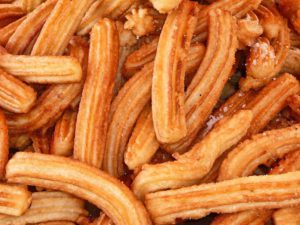
The Chinese make similar fried dough sticks for dunking in Congee or milk for breakfast, although these are not as sweet. Many cooking techniques were adopted from the Chinese. After all, isn’t China where noodles came from? More on that when we get to Italy! Legend has it that Spanish shepherds would bring the dough with them into the mountains and fry the churros over an open fire. Nowadays, in Portugal, as well as the United States, they are common in carnivals and fairs because they are so easy to make.
Other Spanish desserts that go way back to the ancient spice trade routes are flan and rice pudding. Again, these were easy to make because milk, eggs and rice were common ingredients used in every household.
Portuguese menus are rich in history and meld flavors from the south as well as the north.
Not only did other cultures bring their cuisine to Portugal, but Portugal influenced the cuisine of other countries as well. Salt cod came from the Netherlands and rich desserts were introduced by Japan and these became part of the Portuguese culture. The spice route, passing through the Mediterranean, brought spices to Portugal and influenced the cuisine. Garlic and olive oil were widely used in most dishes. A variety of spices dominate Portuguese cuisine, in addition to red peppers, black pepper, garlic, cinnamon, bay leaves, parsley, coriander, vanilla and saffron to name a few.
Portuguese flavors have worked their way into cuisines all around the world. When a ship landed, some of the crew always stayed behind, thus spreading their nuances. I have tasted delicious Portuguese Sausage and Bean Soup in Hawaii and on Cape Cod in Massachusetts. Portuguese also use wine and olive oil which is widely used along the Mediterranean in many dishes. The Piri Piri pepper became popular after the discovery of South America. These are spicy red peppers now grown throughout the region and used widely in sauces.
Because Portugal borders along the Atlantic Ocean, seafood of many varieties was plentiful. Caldeirada is a popular stew consisting of fish and shellfish with potatoes, tomatoes and onions. Fields and pastures supported beef and pork production. Salt pork was popular before refrigeration used for preservation like cod fish. Many dishes were created with Chourico, (spicy sausage), ham, potatoes, carrots, turnips, chickpeas, cabbage and rice. These all started as peasant food, but rose to become popular in restaurants.
Adobo chicken, is marinated chicken cooked, grilled and served with piri piri sauce.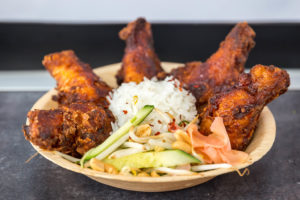
Desserts are much the same as in Spain, relying on eggs and milk as their main ingredient. Cheese is also served for dessert with fruit. Crème caramel, rice pudding and custard tarts. 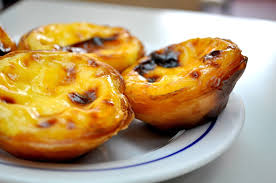 The custard tarts are very similar to a custard dessert, Melktert, popular in South Africa.
The custard tarts are very similar to a custard dessert, Melktert, popular in South Africa.
Talk about crossing cuisines! One of Japan’s favorite baked desserts, is the castella sponge cake. This fluffy cake was introduced to the Japanese by Portuguese merchants in the 16th Century. It has become a specialty of the Nagasaki region in Japan. Flavored with honey, Castella sponge cake is a cross between traditional sponge cakes, and pound cake. It goes really well with tea or for a light dessert.
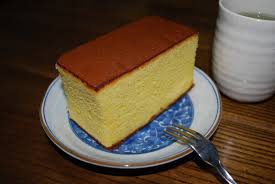
If the Spanish and Portuguese hadn’t needed to look for a different route for their spices, no telling which way history may evolved.
They discovered the new world and with it, many new flavors and recipes. These healthy, delicious spices, changed the way many cultures eat and cook, challenging the imaginations of cooks all along the ancient spice route. If you are looking for any of the spices mentioned here, Go Here for a wide selection of almost every spice you can think of!
Up next, Italy!

Comment
New Season
2020
.
Some Main Products :
Chamomile – Hibiscus –Calendula – Mint –Spearmint- Parsley- Dill tips -Marjoram – Coriander – Sage –Anise – Caraway- Fennel – Black pepper- Fenugreek – Rosemary-Bay leaves – Ginger- Cloves – Paprika – Red hot chili – Thyme – Basil- Cumin – Oregano – White Beans –Beans – Black &Yellow Lemon – Jews Mallow …. More
We Can Make a best offer for you .
waiting for your response soon .
Regards ….
Eng : Nour Elgarhy
Sales Manger
Mobile :+201000725312
Whatsapp : +201000216581
Website : http://www.egyptherbs.com
Location : Egypt – fayoum
Thank you Nour, for this information, I have not heard of your company until now! I will certainly keep you on my list of spice vendors. As always, I am all about helping the small farmers and sustaining a green environment! I prefer to recommend the best and freshest herbs and spices available, and you certainly seem to fit that niche. I believe the world can come together with herbs and spices, I wish you well. Jeanette